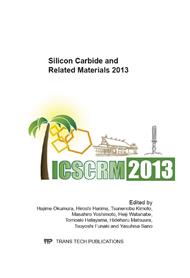p.342
p.346
p.350
p.354
p.358
p.362
p.366
p.370
p.374
Dislocation Analysis of 4H-SiC Using KOH Low Temperature Etching
Abstract:
The conventional KOH etching method at elevated temperatures is an easy way to study SiC dislocations, but presents problems due to an increased etch rate. Here, we examine the application of low temperature KOH treatment for the analysis of dislocation cores and etch pits in SiC. A low energy scanning electron microscope (SEM) is effective to classify dislocation kinds. The scanning transmission electron microscope (STEM) observation of thick samples prepared by the in situ micro-sampling technique enables evaluation of detailed dislocation properties.
Info:
Periodical:
Pages:
358-361
Citation:
Online since:
February 2014
Authors:
Price:
Сopyright:
© 2014 Trans Tech Publications Ltd. All Rights Reserved
Share:
Citation:


